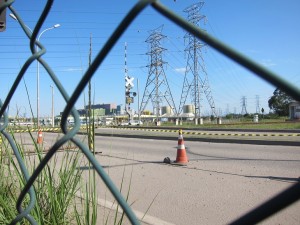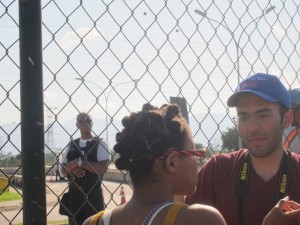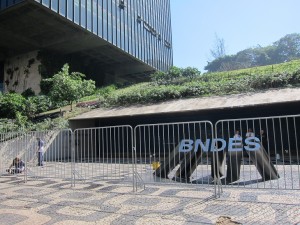People’s Summit Observation- Development from/for whom?
A series of activities and events had been organized by the Brazilian civil society just before the People’s Summit and the official Rio+20 Summit had initiated. Among those, the Rio+Tóxico Tours presented its participants an alternative version of “tourism” of Rio de Janeiro, through the “foreign” existence of the joint ventures between multinationals and Brazilian states and the eyes of those who have been deeply affected by such “development” and collaboration”.
Alternative Tourism: the Rio+ Tóxico Tours

The TKCSA factory was “protected” by a wired fence in a distance. The villagers in the neighborhood thus de-route for the transportation to the other villages because the fence of TKCSA had blocked various local roads.
The Rio+Tóxico Tours were organized by a dozen of Brazilian civil society organizations (e.g. Mais Democracia,Jublieu Sul and so on) in wishes to expose how the suburbs of the metropolitan Rio de Janeiro area have suffered from the industrialized mega projects proposed or financed by the Brazilian governments. 3 tours were organized for the participants to observe on-site the severe impacts on the local communities and territories in the region brought by the so-called “development” proposals.
The relevant projects include: ThyssenKrupp Steel’s Steel Plant in Sepetiba Bay (ThyssenKrupp Companhia Siderurgica do Atlantico, abbreviated as TKCSA), the Reduc refinery and petrochemical complex in Guanabara Bay. These projects have received partial funding or support from the Brazilian National Bank of Economic and Social Development (BNDES), claiming to boost development for the Brazilian society. Yet, these development investments have been found to be merely acts of “greenwashing”, fostering development through the deprivation of the resources and the quality of life of the locals.
For instance, TKCSA is a joint venture formed by the German steel tycoon ThyssenKrupp Steel with the support of BNDES, is believed to be the largest steel company in Latin America. After strong refusals of building the TKCSA plant in many other countries and other Brazilian states, TKCSA’s site were finally confirmed to be around the Sepetiba Bay, which is known as a region full of rich natural resources. Ever since the TKCSA initiated its operation in the region, the processes of steel installation and treatment have brought various social and environmental impacts. With the contamination of seawater with metals from steel production, local fisheries and tourism had been severely affected, so have been for the health and safety of the local inhabitants.
The exhaust emission from the TKCSA site had brought along the “silver rain”, which was proven to be hazardous as several laboratories had discovered the presence of different pollutants as well as other chemicals and heavy metals in their analysis. Consequently, the health and living conditions of the local inhabitants, along with the local nature resources, were put in jeopardies. Fishermen were forced out of employment because the Sepetiba Bay was contaminated; in addition, they were denied the access to the bay due to the security controls of TKCSA.

Armed security guards carried on the surveillance duties and observed the actions of the participants of the Rio+ Tóxico Tour.
During the Rio+Tóxico Tour, the participants had visited the TKCSA factory site and observed how the “security” measures were implemented by TKCSA on site. The factory site is surrounded by a series of high fences, and these fences are within a radius of 1 km from the actual factory site, which promptly makes the TKCSA territory looking as a “reign” of its own in the region.
Armed security guards were constantly patrolling around the entrance with severe surveillance in front of a small gate that would only permit a single person to pass through. Additionally, some of them even started filming and taking photos of the participants of the Rio+Tóxico Tour without obtaining their prior consent; those images were believed to be kept by TKCSA’s internal staff as “evidences” for possible future legal conflicts.
Game/Manipulation between the Government and the Multinationals
BNDES is Brazil’s national development bank, which is being used as a mechanism for the Brazilian government to support activities related to economic development and infrastructure investment. The government lends to the bank at below-market rates, enabling it to make subsidized loans to a broad range of companies. BNDES also has an important counter-cyclical role, as it increased lending by almost 50% to help cushion Brazil’s economy against the fallout from the global financial crisis in 2009.
TKCSA is just one of the plenty mega projects constructed through the “support” of BNDES, which is supposed to be a public bank with essential influence on the economy and “development” of Brazil. Other notorious mega projects that BNDES are involved in include the Belo Monte Hydroelectric Power Plant, where BNDES intends to finances 80% of its construction without taking into account the public opinions and civil society’s actions against this project and the rights of the population that might be affected by this project in the area.
Other projects that BNDES have implicated include the construction of Angra 3 Nuclear Plant, the Transcarioca Highway and renovation of the Maracanã stadium. In the former case, BNDES intend to contribute around 90% of its construction cost, despite the controversies of nuclear plants, the potential risks in its operation and the treatment of radioactive nuclear waste. BNDES disregards the irregularities and human rights violations committed in these endeavors.
BNDES has a 100% state budget, which is about two or three times larger than that of  the World Bank, yet it has not made good use of the amount given. According to the staff of Mais Democracia, « BNDES is responsible for mega projects related to the export of commodities and infrastructure, causing major social and environmental impacts in Brazil and abroad.”
the World Bank, yet it has not made good use of the amount given. According to the staff of Mais Democracia, « BNDES is responsible for mega projects related to the export of commodities and infrastructure, causing major social and environmental impacts in Brazil and abroad.”
The meeting point of the Rio+Tóxico Tour was by the front gate of BNDES. Situated in the Carioca district (the heart to the economic and business activities in Rio de Janeiro), BNDES has an equivalently notorious “neighbor” to its office site, Petrobras. This has somehow explained the “close” relationships between the Brazilian government and the enterprises, as Petrobras is now remembered as one of the executors for the damage it has brought to the people and the environment in Magé, Guanabara Bay.
Brazil in the Spotlight: Development from/for whom?
Brazil has been constantly under the spotlight in thanks to its rapid development. As one of the BRICS country, Brazil’s rich natural resource has assisted the country to progress faster than ever. Its development has accelerated continuously with the preparation of the coming mega events, such as the Confederations Cup (2013), World Cup (2014), and the Olympics Games (2016).
While Brazil was bustled with the preparation of Rio+20, its newly revised Forest Code were being given lots of attention from the international activists and media, worrying the revised content will indirectly encourage more abuses of the Brazilian natural resources. As predicted, the results of the Rio+20 Summit did not encourage the nations to advance with solid goals; instead, a lot of declarations were made to “show” the world that there have been some efforts- but these are not enough. What are truly at stake are the communities that were “forced out” of their home due to these mega- events or mega infrastructure projects.
Take the residents of Speedway Village (Vila Autódromo) as an example; since the announcement of the next Olympics game (2014) will be held in Brazil, the residents have thus become the target with the threats of the removals. This is the first time though. With the expansion of the city, the community located in this area has become the target of the greedy speculators and large construction companies. Its residents have learned to resist, asserting their right to housing before the power of the real estate market which has coupled with successive governments.
Although the Speedway Village is a community occupied by the inhabitants, its occupation is legal as it represented the result of organized urbanization by the residents over the decades. The right to housing was guaranteed by the Constitution, the right to the land use was expressed in the Royal Court and the Right to Use was this territory was given to the residents of the community by the State Government.
During the preparation of the Pan- American Games, the inhabitants of the Speedway Village had continuously resisted to be removed from the district, which had evidently demonstrated how democratic sports events can be held under the coexistence of social housing. Yet, with the preparation of the 2016 Olympic Games, the city government had made various attempts and excuses to demolish the neighborhood.
Resistance vs. Conscientious
These stories are just tips of the icebergs; more communities in Brazil are still struggling to resist for their right to live and confronting the governments and multinationals with their conspiracies. Such development strategies are developed based on the deprivation of the resources and rights of the poor and less advantaged. One could not help but wonder how such “neo- colonialism” has not contributed to the well- beings of the citizens; they have brought nothing bur more fatal social and environmental impacts that might cause the life of everyone in the end.
Shortly after the closure of the People’s Summit for Social and Environmental Justice, some sad news was spread from Brazil. It was suspected that some fishermen activists disappeared when they went to work ; they were found dead 3 days later. These activists had just participated the meeting and sharing at the People’s Summits, as they had actively battled against the mega- projects in the state of Rio de Janeiro and its impacts on the residents and environment in the region.
Unfortunately, they were not the first activists whom have encountered or threatened by death threats, physical attacks and killings. There had been more “incidents” in the past, yet such stories had usually not been covered by the local or international media. Such incidents had also created certain fears for the activists in the movements and the local supporters, worrying such resistance and lobbying to the mega- projects might further endanger common people’s life and lead further destruction on their family life.
The closure of Rio+20 Summit does not signify the end of the process to fight for the social and environmental justice; yet, with the contradictions and conflicts of interests, Brazil is torn by its society while it seeks for faster and stronger development. With the rise of the income and the appearance of the so- called new middle class, corruption still exist as a major and fatal issue in the Brazilian administration system. Issues like inadequate health care, racial integration, class prejudice, land grab and so on are still hidden in the shadows of the glorious development of Brazil; the fast- growing development was merely a fantasy constructed through the stealing of people’s rights and common goods.















